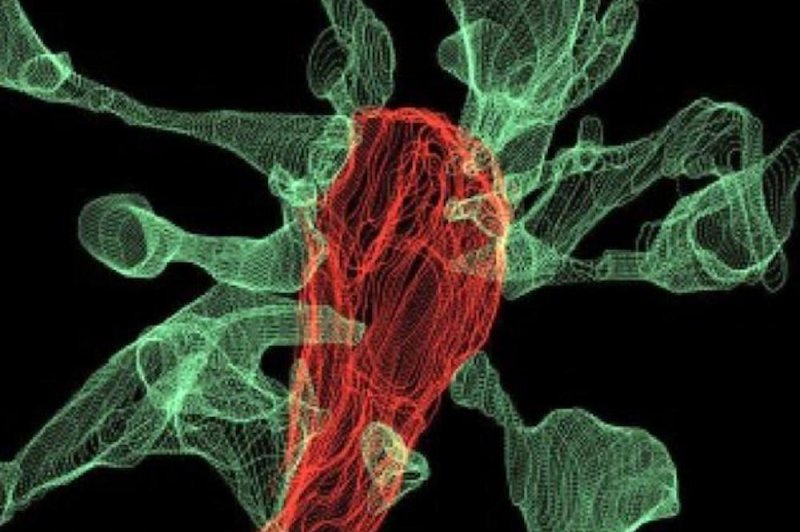An image captured using focused ion beam scanning electron microscopy shows the tiny fingers of several synapses, called filopodia, interacting with a single microglia, pictured in red. Photo by L. Weinhard/EMBL Rome
March 26 (UPI) -- For the first time, scientists have filmed microglia eating brain synapses.
Braining-eating entities aren't usually welcomed inside the brain, but microglia are vital to brain development and the immune defense of the central nervous system. Roughly one in ten brain cells is a microglia cell.
Scientists have long proposed that microglia help reinforce neural pathways by nibbling away at unnecessary synapses. Until now, however, no one had observed the process directly.
Using advaced imaging technology and the brain of a mouse model, scientists at the European Molecular Biology Laboratory were finally able to witness microglia chewing on brain synapses.
"Our findings suggest that microglia are nibbling synapses as a way to make them stronger, rather than weaker," lead researcher Cornelius Gross, scientist with EMBL Heidelberg, said in a news release.
The images showed brain synapses extend tiny appendages called filopodia to greet and interact with nearby microglia. In one instance, researchers observed 15 filopodia extending toward a microglia cell as it nibbled on a synapse.
The observations, detailed this week in the journal Nature Communications, suggest microglia cells aren't trash collectors so much as contractors.
"As we were trying to see how microglia eliminate synapses, we realized that microglia actually induce their growth most of the time," researcher Laetitia Weinhard said.
Researchers believe microglia may play an important role in the formation of double synapses, which allows the terminal end of a single neuron to relay neurotransmitters to two neighboring neurons instead of one.
"This shows that microglia are broadly involved in structural plasticity and might induce the rearrangement of synapses, a mechanism underlying learning and memory," Weinhard said.
The moving pictures of synapse-eating microglia were possible by a combination of correlative light, and electron microscopy and light sheet fluorescence microscopy.
Scientists plan to use the imaging technology to study microglia behavior during adolescent brain development. Researchers are also keen to investigate the link between microglia and neural disorders like schizophrenia and depression.
"These findings allow us to propose a mechanism for the role of microglia in the remodeling and evolution of brain circuits during development," Gross said.















